Opinion
New New Deal: Toward a New Era of Social Imagination
The community-centered approach of the Federal Art Project can be an inspiration in a time when the current system must be rethought.
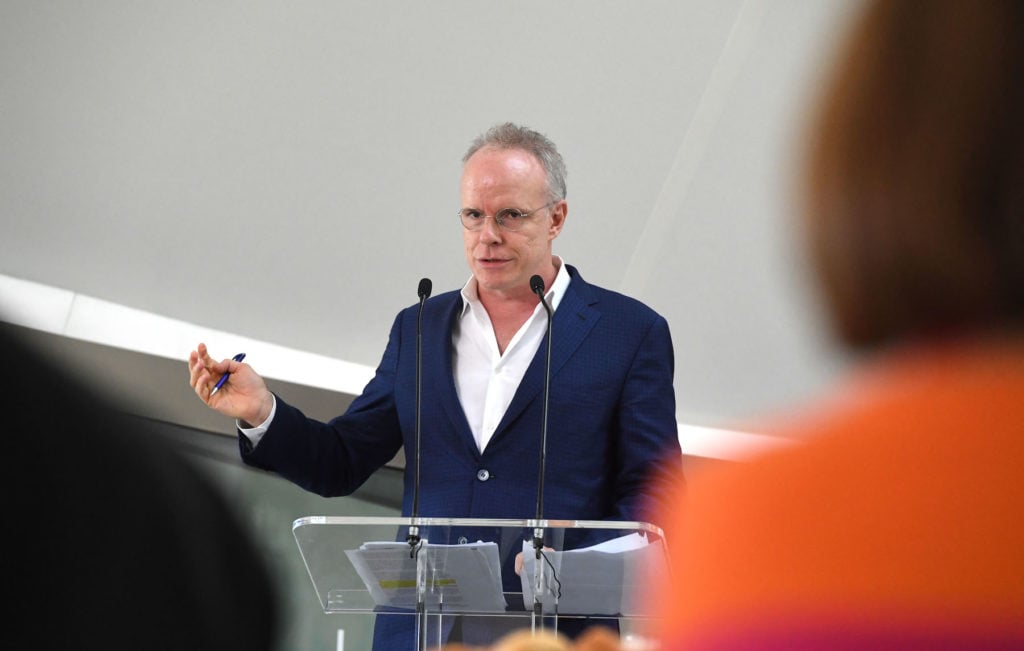
The community-centered approach of the Federal Art Project can be an inspiration in a time when the current system must be rethought.

Hans Ulrich Obrist

I recently came across a collective document called “The Grey Briefings,” written by the Special Circumstances Intelligence Unit, a global group of 90 futurists, writers, designers, technologists, and policy makers. The question they ask is this: “What would happen to Europe and North America if COVID-19 lasted a year or more?” Using software from MIT, they uncover three scenarios, all of which mean saying goodbye to the world as we know it.
All three begin with massive unemployment. Scenario One is the Pyramid Scenario, where governments enact policies that benefit the rich, which will result in exacerbated inequality, poverty, and violence. Scenario Two is the Leviathan Scenario, where governments expand their powers and use them to deliver social goals and collective benefits. The third is The Village Scenario, where ineffective and unsustainable state responses lead to fragmentation and fragile local DIY solutions and support.
According to the briefing, the scenario that pays off in the end is the Leviathan Scenario, where everyone makes sacrifices and is mobilized to develop local solutions, creating bottom-up experimentation with government support. There is a focus on public goods and social welfare, transforming the economy and creating a more resilient and sustainable foundation. This will lead to post-crisis recovery and result in a New New Deal.
Based on the Works Project Administration introduced in America in 1935, such projects would focus on new public networks, digital services, widely accessible next-generation health-care systems, and climate-resilient energy, transport, and housing projects. Governments would act as both guides and delivery partners.
The briefing ends with some pertinent questions. What might a Post-COVID-19 Renaissance look like? Could a long-term COVID crisis provide stimulation for a new era of social imagination? How can we imagine a more healthy, satisfying, and fair world in light of the challenges posed by this “Great Transition”?
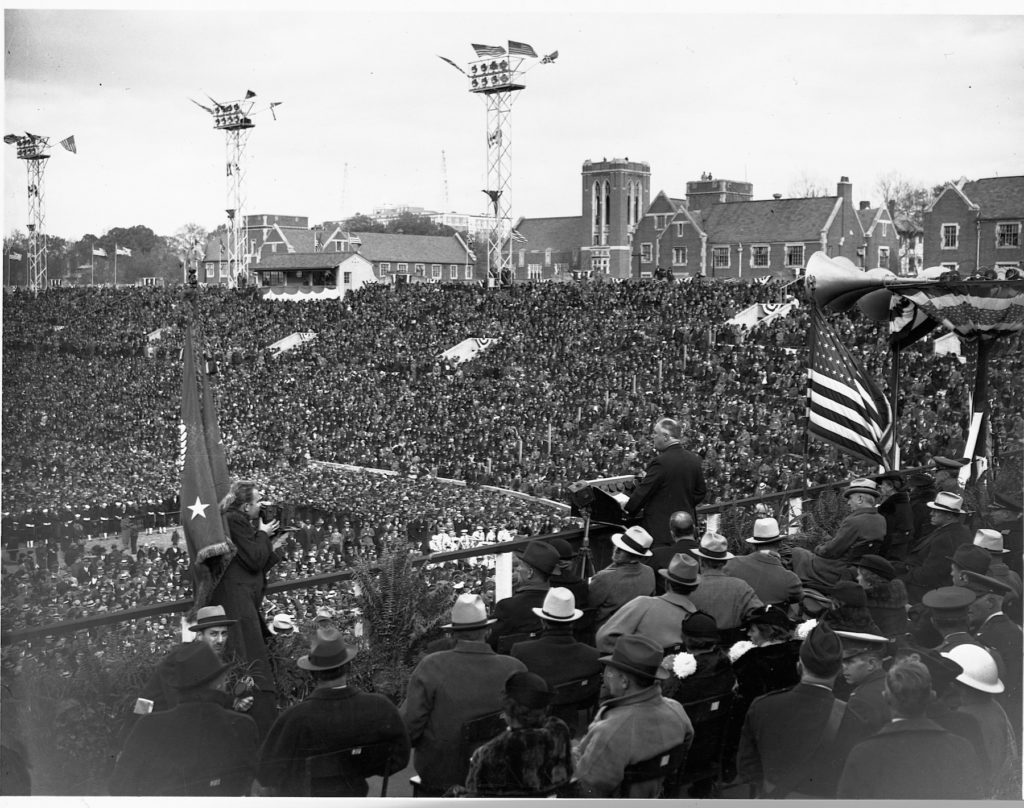
President Franklin Delano Roosevelt addresses crowds at Grant Field and defends the New Deal. Photo by Bettmann/Contributor via Getty Images.
In terms of culture, the challenge, according to the briefing, will be in navigating a delicate balance between honoring people’s concerns about change and encouraging them to experiment and be open to new ideas. As president Franklin D. Roosevelt, author of the New Deal, wrote in 1932: “The country needs, and—unless I mistake its temper—the country demands bold, persistent experimentation. It is common sense to take a method and try it: if it fails, admit it frankly and try another. But above all, try something.”
The future is often invented from fragments of the past. In the late 1990s, I was friendly with Helen Levitt (1913–2009), the extraordinary street photographer, filmmaker, and friend of Walker Evans. Levitt told me that Evans told her at length that during the Great Depression he participated alongside Dorothea Lange, Gordon Parks, and many other American photographers in the Farm Security Administration (FSA) photography program, which was organized as part of the New Deal in 1937 by Roy Stryker and produced 250,000 images of rural poverty.
Levitt told me that should there one day be a major global crisis that would shake society to its roots (such as the one we are living through now), we should revisit the legacy of Roosevelt’s New Deal and what it did with and for culture. Remembering her words, I found my notes recording what she had told me: how to put in place democratic and decentralized government art patronage, and how to connect the artist and the social environment. Levitt also made me aware that these projects of large-scale governmental support of artists had a predecessor in 1926, when the Mexican government paid artists to decorate public buildings with murals.

Jackson Pollock, Going West (1934-35). Image via Wikiart.
In the US, government support for art started in 1933 as a direct result of the Great Depression, which began in 1929 and led to mass unemployment. As cultural historian Robert C. Vitz points out, “the magnitude of the crisis forced artists to explore ways of combatting their traditional isolation and eventually through artist organization and with the help of several government art programs they found a new sense of community and a new role in American Society.” Vitz describes how Morris Graves wandered through the West selling paintings on the roadside, how Jackson Pollock travelled across the country hitching rides and jumping freight trains, how Arshile Gorky called the Depression years “the bleakest, most spirit-crushing” period of his life, and spoke of the “futility of such paralyzing poverty for the artist.” He also tells us how Marsden Hartley wrote that “the uncertainty adds no whit whatever to the peace of mind that is necessary for decent work.”
Artists lost most of their previous private philanthropic support, and the many cooperative events and markets (such as the Society of independent Artists’s art market held at the Grand Central Palace in NYC in 1931) did not provide the necessary income. One initiative was put forward by the American Society of Painters Sculptors and Gravers, who in 1935 suggested that museums should pay rental fees to the living artists whose work they exhibited. Only a few museums, like the Whitney Museum of Art and the San Francisco Museum complied, so this failed to raise the necessary income. It became increasingly obvious that only a large-scale governmental initiative could bring solutions.
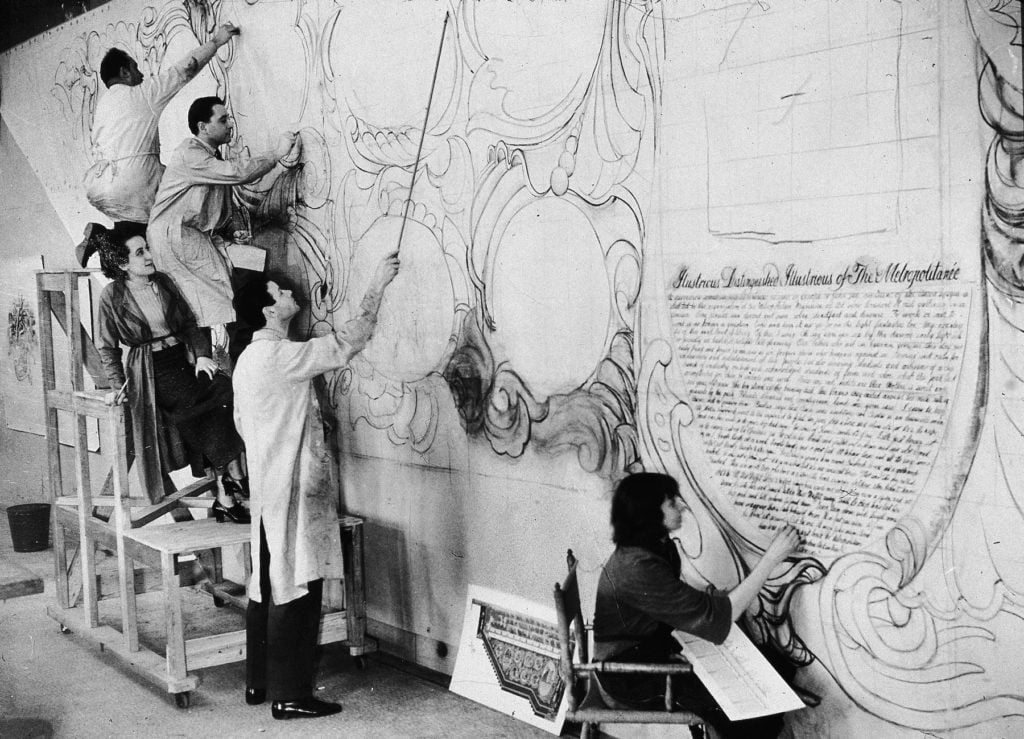
American artist Allen Saalburg directs WPA artists at work in a temporary studio at the American Museum of Natural History on murals commissioned for the Arsenal Building in Central Park, New York, New York, 1935. Photo by New York Times Co./Getty Images.
As art historian Erica Beckh writes, a momentous meeting took place in the home of Edward Bruce in Washington, DC on December 8, 1933. Bruce was an artist, lawyer, businessman, publisher, and collector. His generalist mind and pragmatic spirit were instrumental in creating a scheme to help artists. He gathered many museum directors from all over the country to convene at the one-day long meeting, which was also attended by Eleanor Roosevelt and chaired by Roosevelt’s uncle Frederic A. Delano. Here, the first Federal art program, the Public Works of Art Project (PWAP) was defined, with the aim of providing work for American artists through commissions, for example sculpture and mural decorations for federal buildings. Beckh summarizes:
Administered by the Procurement Division of the Treasury Department with funds allotted from the Federal Emergency Relief Administration, the PWAP was a part of the Federal relief program. It was directed by a central staff in Washington, assisted by sixteen regional volunteer committees, composed of art museum personnel and the like. The broad aims of the program were (1) to establish democratic methods of government art patronage, (2) to decentralize artistic activity throughout the entire nation, (3) to encourage the emergence of young, unknown talent, (4) to increase the general public appreciation of the arts, and (5) to promote a closer interrelation of the artist with his social environment.
The PWAP came to an end in 1934 and was replaced by two independent programs. The first, again under the directorship of Bruce, was called the Section of Painting and Sculpture (which later become the Section of Fine Art) and was a permanent agency, no longer part of the Treasury’s relief fund. It commissioned professional artists to decorate federal buildings and was organized through open, anonymous competition. The idea was to create more interest in the arts within society.
As the artist/muralist George Biddle wrote in 1940, “This employment of over 600 artists in almost 800 American cities has not cost the taxpayer one additional cent of money. It has been financed through the earmarked use of a Congressionally-voted building allocation.” Biddle also noted that the “policy of selecting by open competitions coupled with the decentralization (inherent in the fact that the building program itself is located almost entirely in small towns) is in my mind the greatest contribution and the healthiest influence of the section.”
The second project, under the directorship of Holger Cahill, was called the Federal Art Project (FAP). Intended to bridge fine art, public art, popular art, craft, industrial arts, and folk arts, it was part of the Work Progress Administration (WPA, renamed the Work Projects Administration in 1939), a New Deal agency that employed millions of job-seekers to carry out public works such as the construction of public edifices, roads, and other large-scale works. One of the main problems with the Section of Fine Art was that often artists were paid in several installments, and each step needed to be approved, which often led to a lack of risk-taking and to compromise in the result of the murals. Under the FAP, however, every participating artist received a salary, which required less supervision.
In Cahill’s own words, “It is the function of our time to organize great democratic and participatory cultural programs for restoring the relation between artist and public. The shock needed to set the program going was the Great Depression, which made it clear that unless the organized community stepped in, the arts would enter a dark from which they might not recover for generations.”
The FAP encompassed
—Fine Arts: murals, sculpture, easel painting, graphic art. The murals had the biggest outreach, or in the words of muralist George Biddle, “Whenever mural art had reached its fullest expression, there had also been a universal religion—that is, a common social faith or purpose which the artist had shared with all classes of society.”
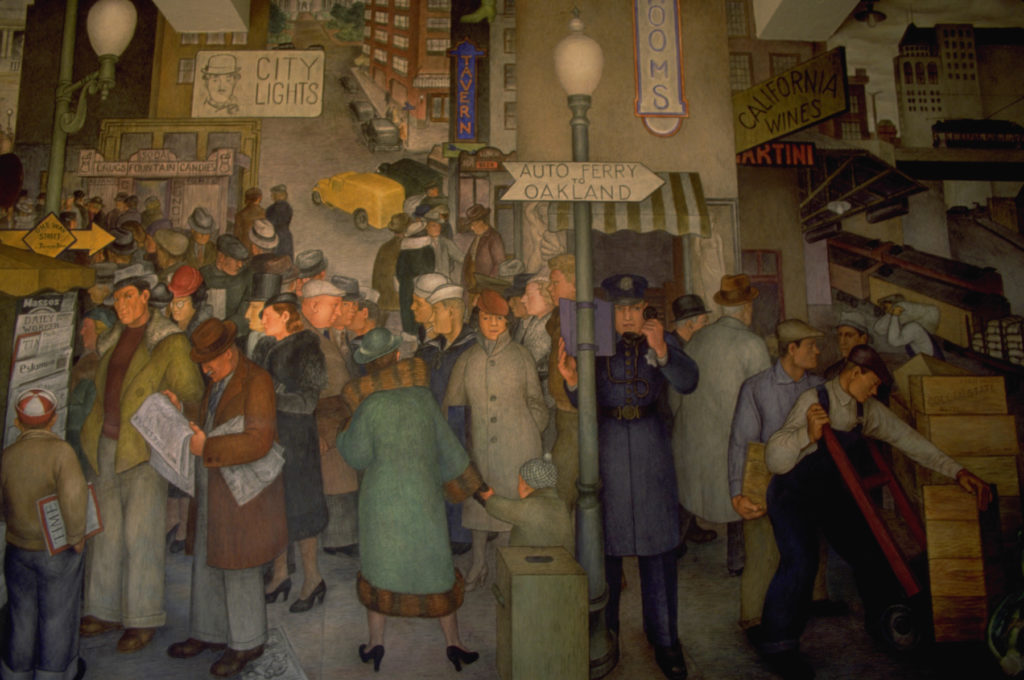
Detail of City Life mural at San Francisco’s Coit Tower by Victor Arnautoff. Photo by © Robert Holmes/CORBIS/Corbis via Getty Images.
—Practical Art: posters, photography, arts and craft, dioramas, stage sets. This included the Index of American Design, an encyclopedic survey of decorative arts and folk arts in the US in the 19th century. That project is composed of more than 18,000 plates depicting American crafts and textiles.
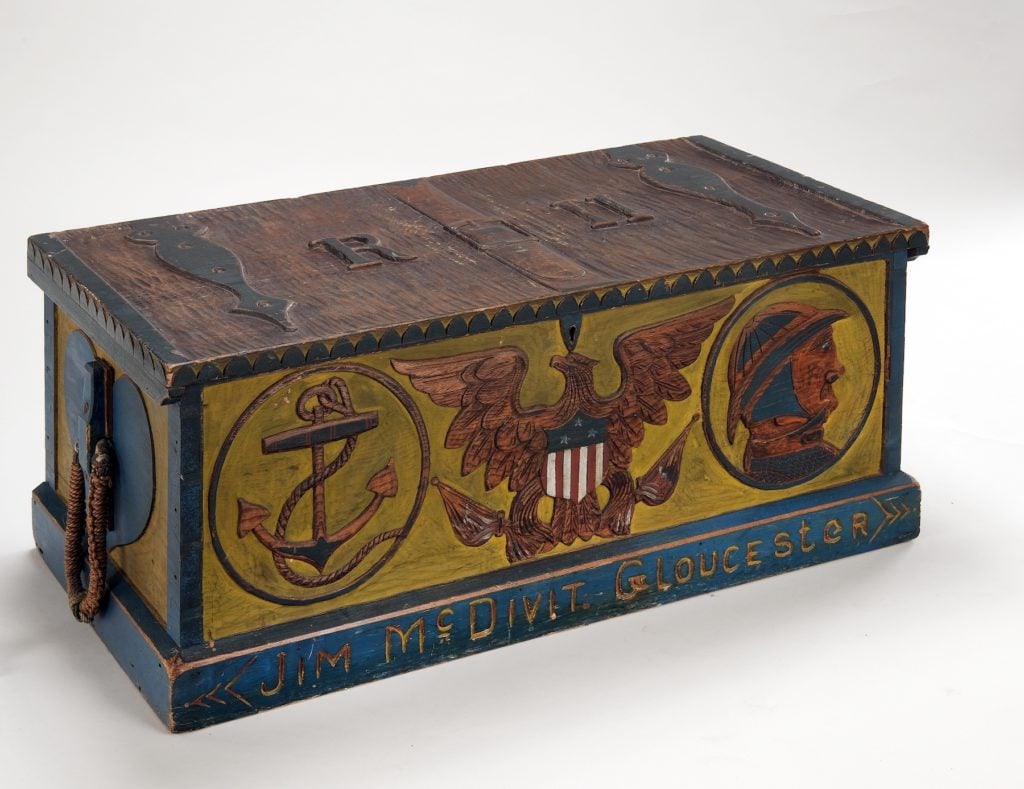
American Sea Chest (circa 1840), a painted and carved storage box, an item illustrated in the Index of American Design. Photo by Sepia Times/Universal Images Group via Getty Images.
—Educational Services: galleries and art centers, art teaching, research and information. Of particular importance was the creation of more than 100 community centers, as it brought generations together and made art accessible to many more people.

Poster for Harlem Community Art Center. Image via Wikimedia Commons.
As George J. Mavigliano wrote:
Community art centers helped break down the strange notion that art could only be appreciated by a limited group of people. Growing numbers of people began to see the value of art as a recreational pastime which formed a link between the professional artist and the layman, broadening the scope of art in the community. Both of these programs were to serve as a means of introducing art into many American communities hitherto barren of art and art interest.
Mavigliano reminds us of Cahill’s speech at philosopher John Dewey’s eightieth birthday, where he emphasized the value Dewey gave to seeing art in daily life and to connecting art and society. He believed that art should not be looked upon as a mere frill to standard education, but something to be experienced through participation.
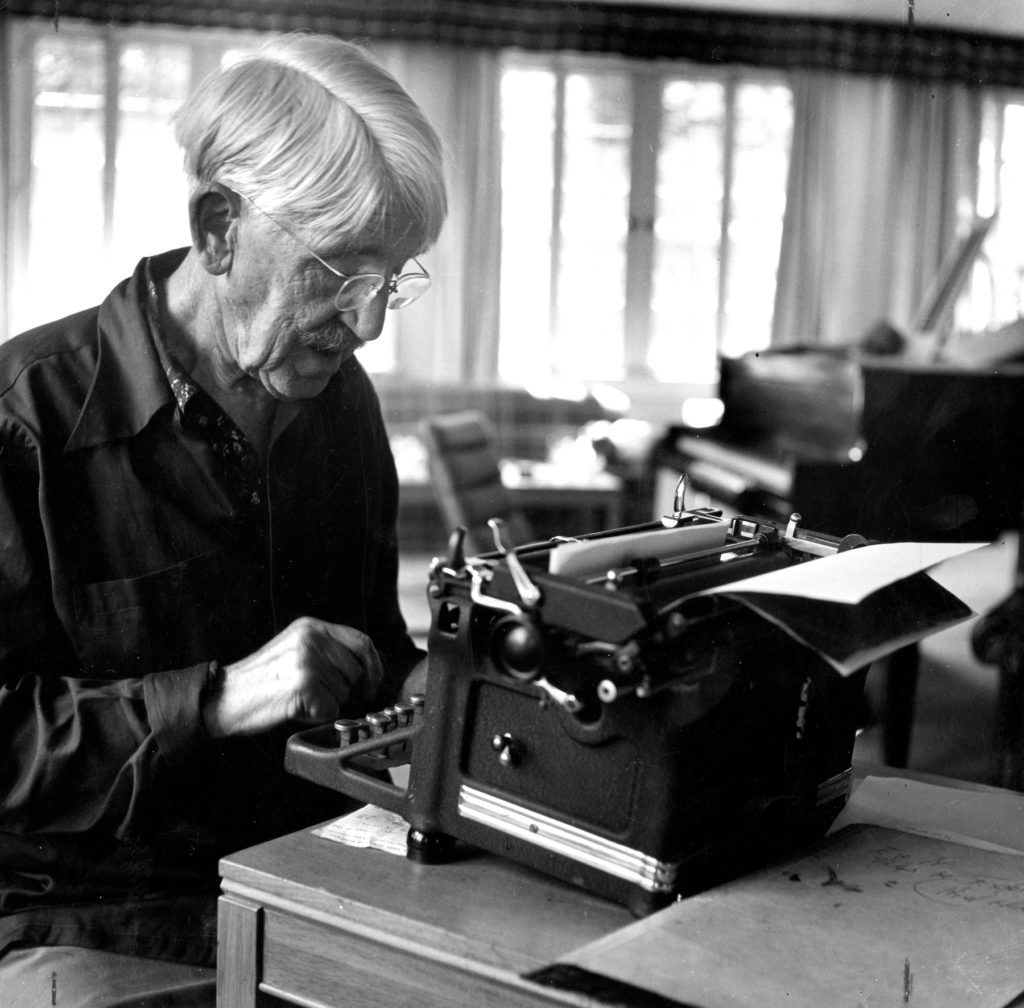
American philosopher, psychologist, and educational reformer John Dewey sitting at a typewriter, 1946. Photo by JHU Sheridan Libraries/Gado/Getty Images.
Cahill wrote that his inspiration from his teacher Dewey came from “the fact that philosophic ideas have a way of getting translated into programs of action… the thought of the philosopher makes its way into the homely experience every day.” He was inspired by Dewey’s book, Art as Experience (1934), which reads like a manifesto for the democratization of art and was one of the major inspirations for my own “Do It” exhibition project. Art as Experience describes how “the growth of capitalism has been a powerful influence in the development of the museum as the proper home for works of art, and in the promotion of the idea that they are apart from the common life.” Dewey wanted to recreate a continuity between the refined and intensified forms of experience that he attributed to the work of art and the everyday events that form our experience.
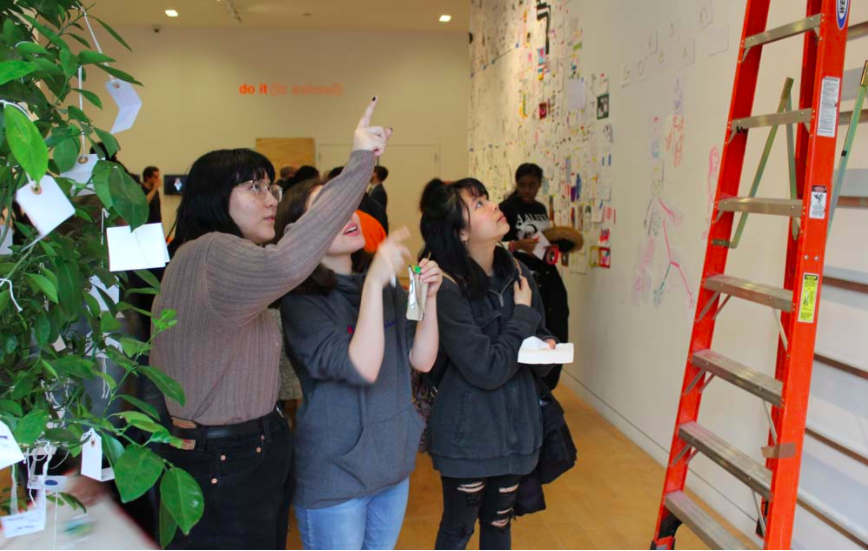
Installation view of “do it” at the Hunter College’s East Harlem Gallery, 2019. Courtesy of Seamus Gallagher and ICI.
As Jillian Russo notes, “For Dewey, philosophy required practical application, testing, and active participants to enact reform.” This is exactly what Cahill did at the FAP, which became a large, concrete practical laboratory where he applied and disseminated Dewey’s ideas.
After Pearl Harbor and the US entry into World War II, the conservative-minded Congress became increasingly opposed to government art projects. It had been an amazingly productive five years of art patronage, resulting in thousands of public artworks. Millions of people attended arts and craft classes in the 107 community centers, which were open to everyone. The anonymous competitions, both regional and national, also created a sense of community. Exhibitions were held that were seen by millions, with many people in regional places where there were no museums experiencing original works of art for first time.
The program’s many initiatives allowed young artists the possibility to work in an otherwise destitute environment, and triggered an explosion of creative talent in the following decades. Stuart Davis, Marsden Hartley, Arshile Gorky, Philip Guston, William de Kooning, Lee Krasner (who said that the WPA saved her life), Jacob Lawrence, Norman Lewis, Alice Neel, Ad Reinhart, and Mark Rothko all benefited from the scheme at a crucial early moment in their careers despite abysmal conditions.
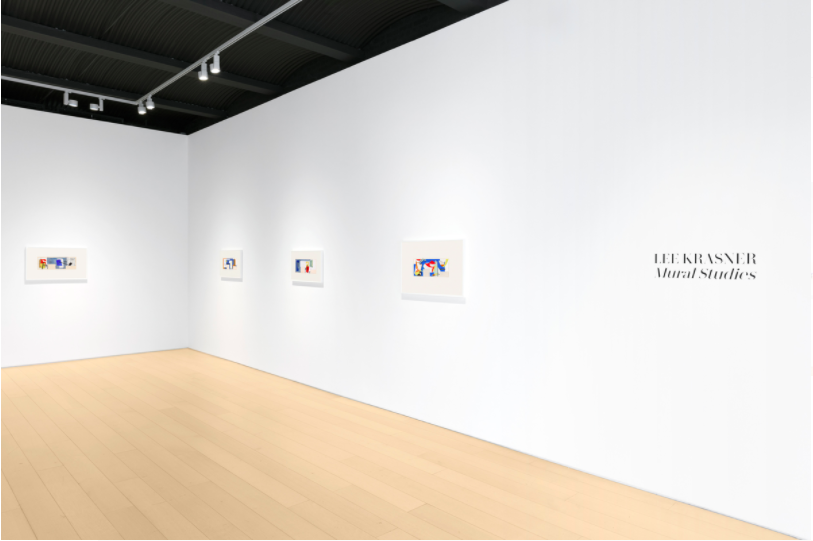
Installation view of “Lee Krasner: Mural Studies” at Kasmin Gallery in 2018, a show of studies for an unrealized WPA mural. Photo by Diego Flores, courtesy Kasmin Gallery.
Today, at this moment of extreme crisis in the world, a deeply worrying and precarious time for artists and for everybody, an art stimulus project similar in scale to the WPA is urgently needed. The idea is highly relevant for the current moment, both in terms of supporting the economy and of helping and caring for artists. In this time, it’s particularly important that (as Helen Lewitt told me in the conversation which triggered this text) art institutions think about how they can go beyond their walls and reach everyone. It is our collective role as public institutions to support artists and culture at this time. When art institutions make their platforms available to artists, many of the dire problems of the world can be explored with honesty and hope. If there was ever a time that the world needed artists, it is now. In the aftermath of the virus, when the world is rebuilding itself, the cities have to step up. The regions have to step up. Countries have to step up. Governments have to help lay out this infrastructure for change.
Thinking about a New New Deal and how the FDR government arts program could be a toolbox for today, it is interesting to visit Jeremy Rifkin’s book The Green New Deal (2019). Here, Rifkin proposes an urgent plan to confront climate change, transform the economy and create a green post-fossil-fuel culture. Similar to the New Deal mobilization and large-scale federal program during the Great Depression, which found support across all political parties and enabled the infrastructure to go into the Second Industrial Revolution, the Green New Deal will generate all electricity from renewable sources, and create jobs and promote research in the new green economy.
It is important to state that this is a very different time from the 1930s and, as Rifkin notes, this is not a replication of FDR’s New Deal. It is rather a Green New Deal for the 21st century centered around locally harvested renewable energies and managed by regional infrastructures that connect across borders like wifi. In the 21st century, every state, city, and country around the world can be relatively self-sufficient in its green power generation and resilience. The Industrial Revolution infrastructure works most effectively and efficiently when it is laterally scaled and connects a multitude of small players. The Green New Deal asks for such laterally scaled cooperatives, all building to a smart green Third Industrial Revolution, working at near-zero marginal costs with a near-zero carbon footprint.
This is end of Part 1 of a 2-part essay. I will be writing a second chapter on the Green New Deal and the arts which will speak about the Serpentine’s “Back to Earth” project.